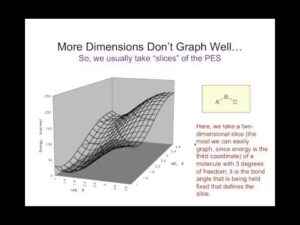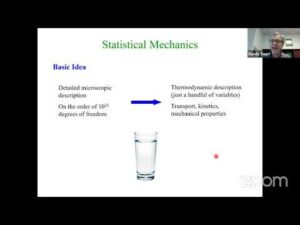Recommended videos


Recommended schools
MolSim is 2-week school in early January that offers a program focusing on numerical techniques for the study of properties of many-particle systems.
The school targets PhD and postdoctoral researchers who want to learn these techniques to study topics in physics, chemistry or biology. The course may also be followed by advanced MSc students. It offers a recap of the statistical mechanics relevant for molecular simulation, and addresses basic and advanced simulation techniques including Monte Carlo, molecular dynamics, free energy calculations, rare events, coarse graining.
The school will have as special focus areas path sampling methods for rare-event simulation. These will be covered with special sessions, including a hands-on part for setting up path sampling for various type of activated processes, by experts in the field. All techniques will be accompanied by illustrative examples of present day research.
The school is open for registration by early October (via https://www.cecam.org). The school has a limited capacity, though the limit remains to be set.
CECAM (Centre Européen de Calcul Atomique et Moléculaire) is an organization devoted to the promotion of fundamental research on advanced computational methods and to their application to important problems in frontier areas of science and technology. As the name suggests, the traditional focus of CECAM has been atomistic and molecular simulations, applied to the physics and chemistry of condensed matter. Over the last twenty years, powerful advances in computer hardware and software have supported the extension of these methods to a wide range of problems in materials science, biology and medicinal chemistry.
link: https://www.cecam.org/program?type=all&month=all&location=all
The Han-sur-Lesse winterschool for physical chemistry has a long tradition to train PhD/PostDoc students of the Netherlands in the basics of static and dynamical aspects of Colloidal, Soft matter, Biophysics, Material science theory and applications. Every year at the end of January or early February up to 35 students come to the Belgian Ardennes town of Han-sur-Lesse to learn from distinguished senior scientists from across Dutch universities such as Technical University Delft, University of Amsterdam, Free University of Amsterdam, University of Utrecht, Twente University, Technical University Eindhoven, Leiden University, and Wageningen University.
Recommended books:
This book provides a practical guide to molecular dynamics and Monte Carlo simulation techniques used in the modelling of simple and complex liquids. Computer simulation is an essential tool in studying the chemistry and physics of condensed matter, complementing and reinforcing both experiment and theory. Simulations provide detailed information about structure and dynamics, essential to understand the many fluid systems that play a key role in our daily lives: polymers, gels, colloidal suspensions, liquid crystals, biological membranes, and glasses. The second edition of this pioneering book aims to explain how simulation programs work, how to use them, and how to interpret the results, with examples of the latest research in this rapidly evolving field. Accompanying programs in Fortran and Python provide practical, hands-on, illustrations of the ideas in the text.
link: https://global.oup.com/academic/product/computer-simulation-of-liquids-9780198803195
Website: https://global.oup.com/booksites/content/9780198803195/
GitHub: https://github.com/Allen-Tildesley/examples
The study of energy landscapes holds the key to resolving some of the most important contemporary problems in chemical physics. Many groups are now attempting to understand the properties of clusters, glasses and proteins in terms of the underlying potential energy surface. The aim of this book is to define and unify the field of energy landscapes in a reasonably self-contained exposition. This is the first book to cover this active field. The book begins with an overview of each area in an attempt to make the subject matter accessible to workers in different disciplines. The basic theoretical groundwork for describing and exploring energy landscapes is then introduced followed by applications to clusters, biomolecules and glasses in the final chapters. Beautifully illustrated in full colour throughout, this book is aimed at graduate students and workers in the field.
link: https://www.cambridge.org/core/books/energy-landscapes/8389839B8AA8E4ADCF0281C37481FF3B
This book provides a detailed description of the techniques employed in molecular modeling and computational chemistry. The first part of the book covers the two major methods used to describe the interactions within a system (quantum mechanics and molecular mechanics). The second part then deals with techniques that use such energy models, including energy minimization, molecular dynamics, Monte Carlo simulations and conformational analysis. The author also discusses the use of more advanced modeling techniques such as the calculation of free energies and the simulation of chemical reactions. In addition he considers aspects of both chemoinformatics and bioinformatics and techniques that can be used to design new molecules with specific properties. Many of the topics are treated in considerable depth but the student is assumed to have only a basic knowledge of the relevant physical and chemical principles.
Understanding Molecular Simulation: From Algorithms to Applications explains the physics behind the “recipes” of molecular simulation for materials science. Computer simulators are continuously confronted with questions concerning the choice of a particular technique for a given application. A wide variety of tools exist, so the choice of technique requires a good understanding of the basic principles. More importantly, such understanding may greatly improve the efficiency of a simulation program. The implementation of simulation methods is illustrated in pseudocodes and their practical use in the case studies used in the text.
Link: https://www.elsevier.com/books/understanding-molecular-simulation/frenkel/978-0-12-267351-1
Complex systems that bridge the traditional disciplines of physics, chemistry, biology, and materials science can be studied at an unprecedented level of detail using increasingly sophisticated theoretical methodology and high-speed computers. The aim of this book is to prepare burgeoning users and developers to become active participants in this exciting and rapidly advancing research area by uniting for the first time, in one monograph, the basic concepts of equilibrium and time-dependent statistical mechanics with the modern techniques used to solve the complex problems that arise in real-world applications.
The book contains a detailed review of classical and quantum mechanics, in-depth discussions of the most commonly used ensembles simultaneously with modern computational techniques such as molecular dynamics and Monte Carlo, and important topics including free-energy calculations, linear-response theory, harmonic baths and the generalized Langevin equation, critical phenomena, and advanced conformational sampling methods. Burgeoning users and developers are thus provided firm grounding to become active participants in this exciting and rapidly advancing research area, while experienced practitioners will find the book to be a useful reference tool for the field.
The extremely powerful technique of molecular dynamics simulation involves solving the classical many-body problem in contexts relevant to the study of matter at the atomistic level. Since there is no alternative approach capable of handling this extremely broad range of problems at the required level of detail, molecular dynamics methods have proved themselves indispensable in both pure and applied research. This book, first published in 2004, is a blend of tutorial and recipe collection, providing both an introduction to the subject for beginners and a reference manual for the more experienced practitioner. It is organized as a series of case studies that take the reader through each of the steps from formulating the problem, developing the necessary software, and then using the programs to make actual measurements. The second edition of the book includes a substantial amount of new material as well as completely rewritten software.
Molecular simulation is a powerful tool in materials science, physics, chemistry and biomolecular fields. This updated edition provides a pragmatic introduction to a wide range of techniques for the simulation of molecular systems at the atomic level. The first part concentrates on methods for calculating the potential energy of a molecular system, with new chapters on quantum chemical, molecular mechanical and hybrid potential techniques. The second part describes methods examining conformational, dynamical and thermodynamical properties of systems, covering techniques including geometry-optimization, normal-mode analysis, molecular dynamics, and Monte Carlo simulation. Using Python, the second edition includes numerous examples and program modules for each simulation technique, allowing the reader to perform the calculations and appreciate the inherent difficulties involved in each. This is a valuable resource for researchers and graduate students wanting to know how to use atomic-scale molecular simulations. Supplementary material, including the program library and technical information, available through www.cambridge.org/9780521852524.
